Nursing Case Study: Comprehensive Care Plan for COPD and Heart Failure
VerifiedAdded on 2022/10/10
|7
|1618
|161
Case Study
AI Summary
This nursing case study focuses on Mrs. J, a patient with a history of hypertension, chronic heart failure, and COPD, admitted to the hospital with progressing heart failure and a relapse of COPD. The case study details her clinical manifestations, including symptoms of flu, fever, wet cough, nausea, chronic fatigue, and irregular heart rate. It outlines the nursing interventions implemented during her admission, such as oxygen therapy, bronchodilators, corticosteroids, and medications like furosemide, enalapril, metoprolol, and morphine. The study also discusses cardiovascular conditions that can lead to chronic heart failure and appropriate nursing interventions, as well as strategies for managing multiple drug interactions in older patients. Furthermore, it presents a health promotion and restoration teaching plan, including dietary and physical activity recommendations, and addresses the management of COPD triggers and tobacco addiction through nicotine replacement therapy and counseling. The importance of patient education regarding medications and potential errors is also emphasized.
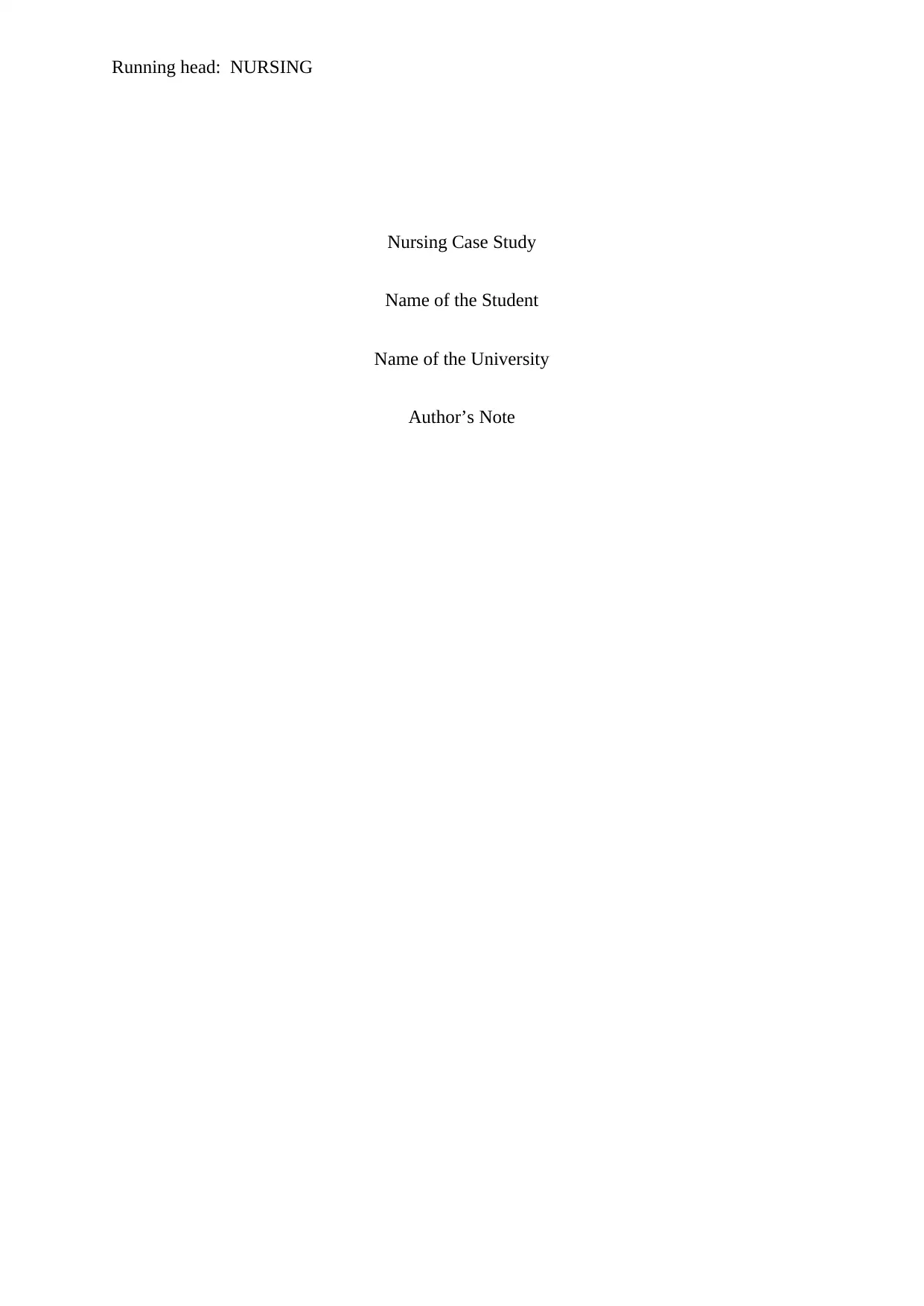
Running head: NURSING
Nursing Case Study
Name of the Student
Name of the University
Author’s Note
Nursing Case Study
Name of the Student
Name of the University
Author’s Note
Paraphrase This Document
Need a fresh take? Get an instant paraphrase of this document with our AI Paraphraser
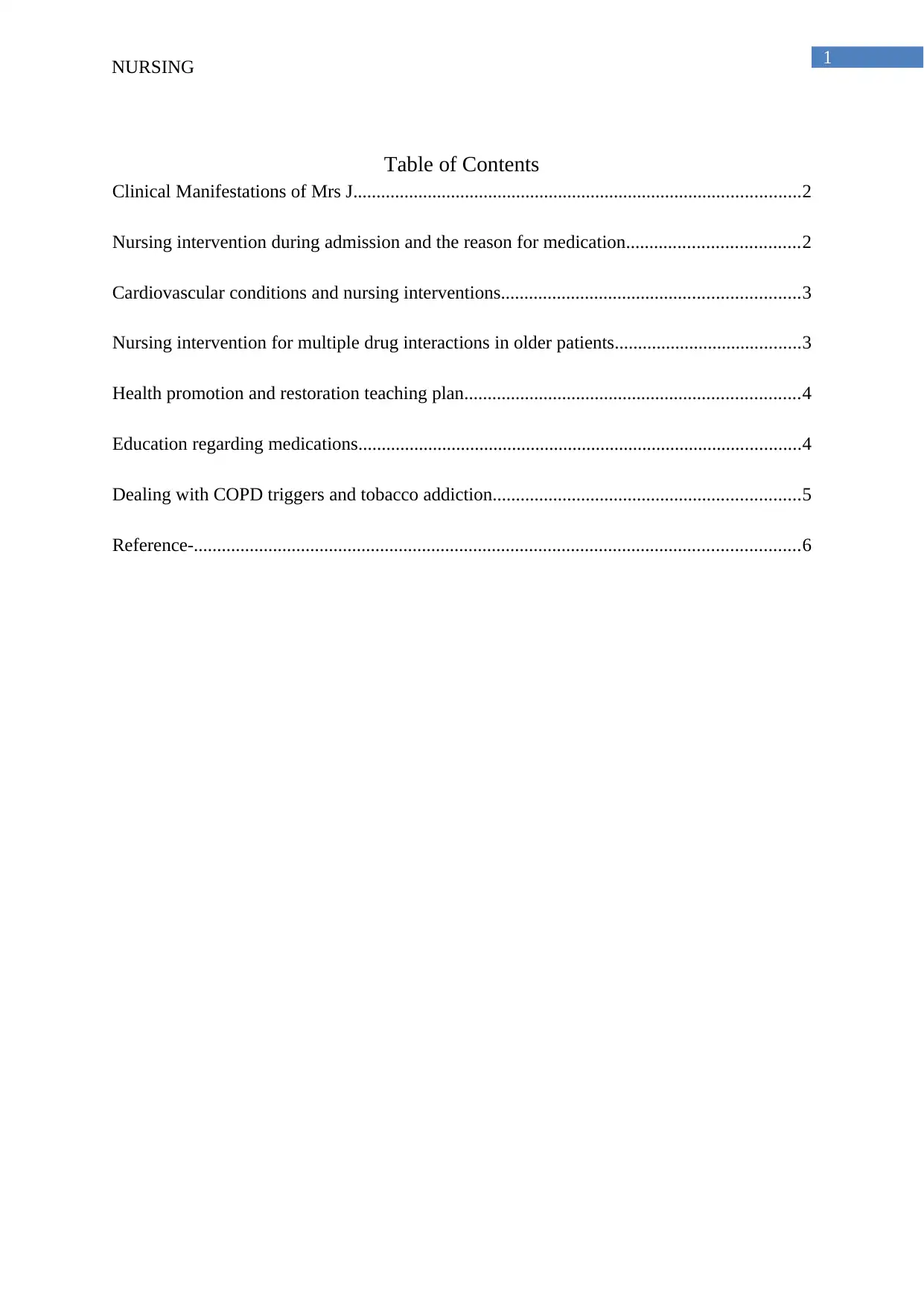
1
NURSING
Table of Contents
Clinical Manifestations of Mrs J................................................................................................2
Nursing intervention during admission and the reason for medication.....................................2
Cardiovascular conditions and nursing interventions................................................................3
Nursing intervention for multiple drug interactions in older patients........................................3
Health promotion and restoration teaching plan........................................................................4
Education regarding medications...............................................................................................4
Dealing with COPD triggers and tobacco addiction..................................................................5
Reference-..................................................................................................................................6
NURSING
Table of Contents
Clinical Manifestations of Mrs J................................................................................................2
Nursing intervention during admission and the reason for medication.....................................2
Cardiovascular conditions and nursing interventions................................................................3
Nursing intervention for multiple drug interactions in older patients........................................3
Health promotion and restoration teaching plan........................................................................4
Education regarding medications...............................................................................................4
Dealing with COPD triggers and tobacco addiction..................................................................5
Reference-..................................................................................................................................6
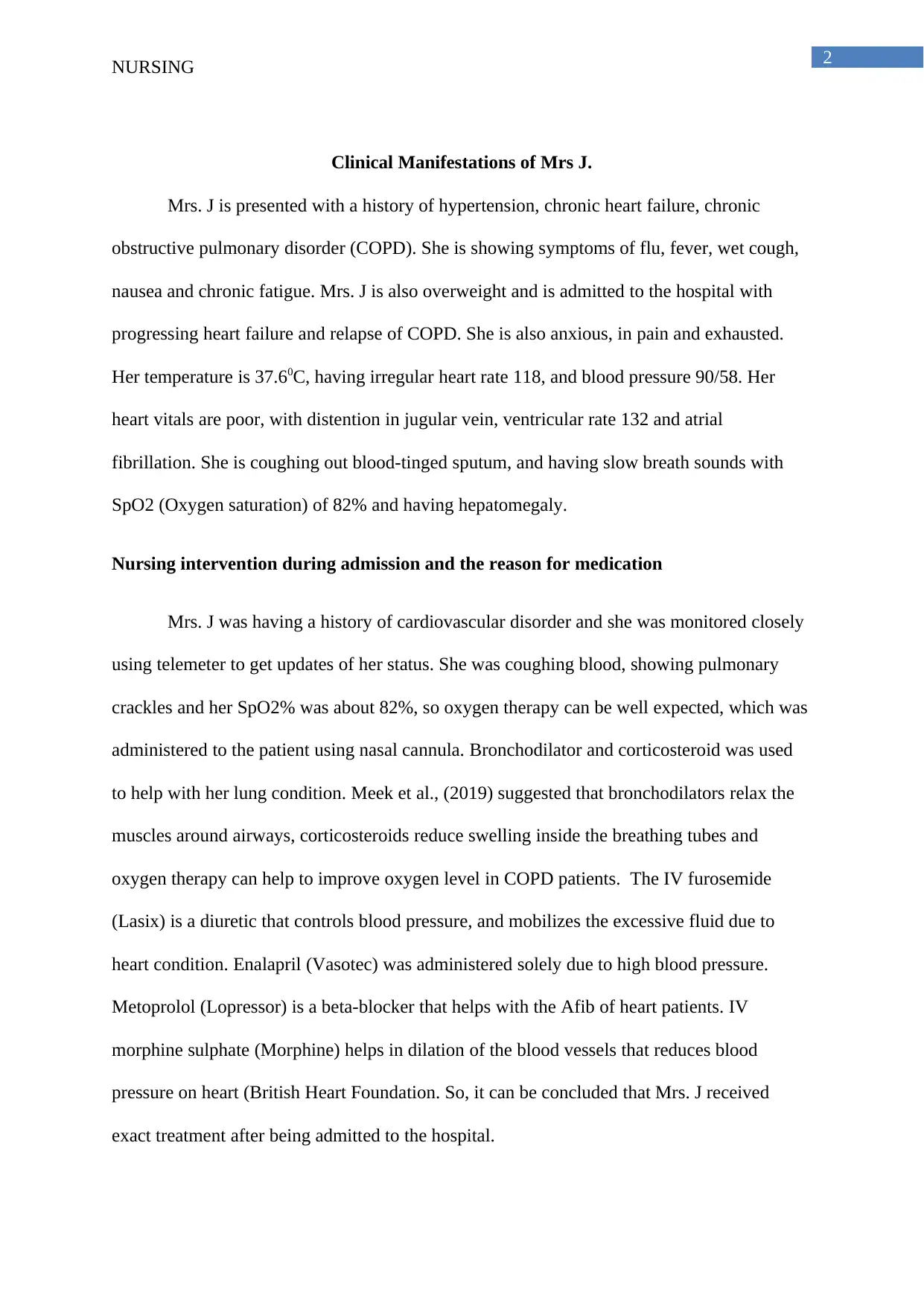
2
NURSING
Clinical Manifestations of Mrs J.
Mrs. J is presented with a history of hypertension, chronic heart failure, chronic
obstructive pulmonary disorder (COPD). She is showing symptoms of flu, fever, wet cough,
nausea and chronic fatigue. Mrs. J is also overweight and is admitted to the hospital with
progressing heart failure and relapse of COPD. She is also anxious, in pain and exhausted.
Her temperature is 37.60C, having irregular heart rate 118, and blood pressure 90/58. Her
heart vitals are poor, with distention in jugular vein, ventricular rate 132 and atrial
fibrillation. She is coughing out blood-tinged sputum, and having slow breath sounds with
SpO2 (Oxygen saturation) of 82% and having hepatomegaly.
Nursing intervention during admission and the reason for medication
Mrs. J was having a history of cardiovascular disorder and she was monitored closely
using telemeter to get updates of her status. She was coughing blood, showing pulmonary
crackles and her SpO2% was about 82%, so oxygen therapy can be well expected, which was
administered to the patient using nasal cannula. Bronchodilator and corticosteroid was used
to help with her lung condition. Meek et al., (2019) suggested that bronchodilators relax the
muscles around airways, corticosteroids reduce swelling inside the breathing tubes and
oxygen therapy can help to improve oxygen level in COPD patients. The IV furosemide
(Lasix) is a diuretic that controls blood pressure, and mobilizes the excessive fluid due to
heart condition. Enalapril (Vasotec) was administered solely due to high blood pressure.
Metoprolol (Lopressor) is a beta-blocker that helps with the Afib of heart patients. IV
morphine sulphate (Morphine) helps in dilation of the blood vessels that reduces blood
pressure on heart (British Heart Foundation. So, it can be concluded that Mrs. J received
exact treatment after being admitted to the hospital.
NURSING
Clinical Manifestations of Mrs J.
Mrs. J is presented with a history of hypertension, chronic heart failure, chronic
obstructive pulmonary disorder (COPD). She is showing symptoms of flu, fever, wet cough,
nausea and chronic fatigue. Mrs. J is also overweight and is admitted to the hospital with
progressing heart failure and relapse of COPD. She is also anxious, in pain and exhausted.
Her temperature is 37.60C, having irregular heart rate 118, and blood pressure 90/58. Her
heart vitals are poor, with distention in jugular vein, ventricular rate 132 and atrial
fibrillation. She is coughing out blood-tinged sputum, and having slow breath sounds with
SpO2 (Oxygen saturation) of 82% and having hepatomegaly.
Nursing intervention during admission and the reason for medication
Mrs. J was having a history of cardiovascular disorder and she was monitored closely
using telemeter to get updates of her status. She was coughing blood, showing pulmonary
crackles and her SpO2% was about 82%, so oxygen therapy can be well expected, which was
administered to the patient using nasal cannula. Bronchodilator and corticosteroid was used
to help with her lung condition. Meek et al., (2019) suggested that bronchodilators relax the
muscles around airways, corticosteroids reduce swelling inside the breathing tubes and
oxygen therapy can help to improve oxygen level in COPD patients. The IV furosemide
(Lasix) is a diuretic that controls blood pressure, and mobilizes the excessive fluid due to
heart condition. Enalapril (Vasotec) was administered solely due to high blood pressure.
Metoprolol (Lopressor) is a beta-blocker that helps with the Afib of heart patients. IV
morphine sulphate (Morphine) helps in dilation of the blood vessels that reduces blood
pressure on heart (British Heart Foundation. So, it can be concluded that Mrs. J received
exact treatment after being admitted to the hospital.
⊘ This is a preview!⊘
Do you want full access?
Subscribe today to unlock all pages.

Trusted by 1+ million students worldwide
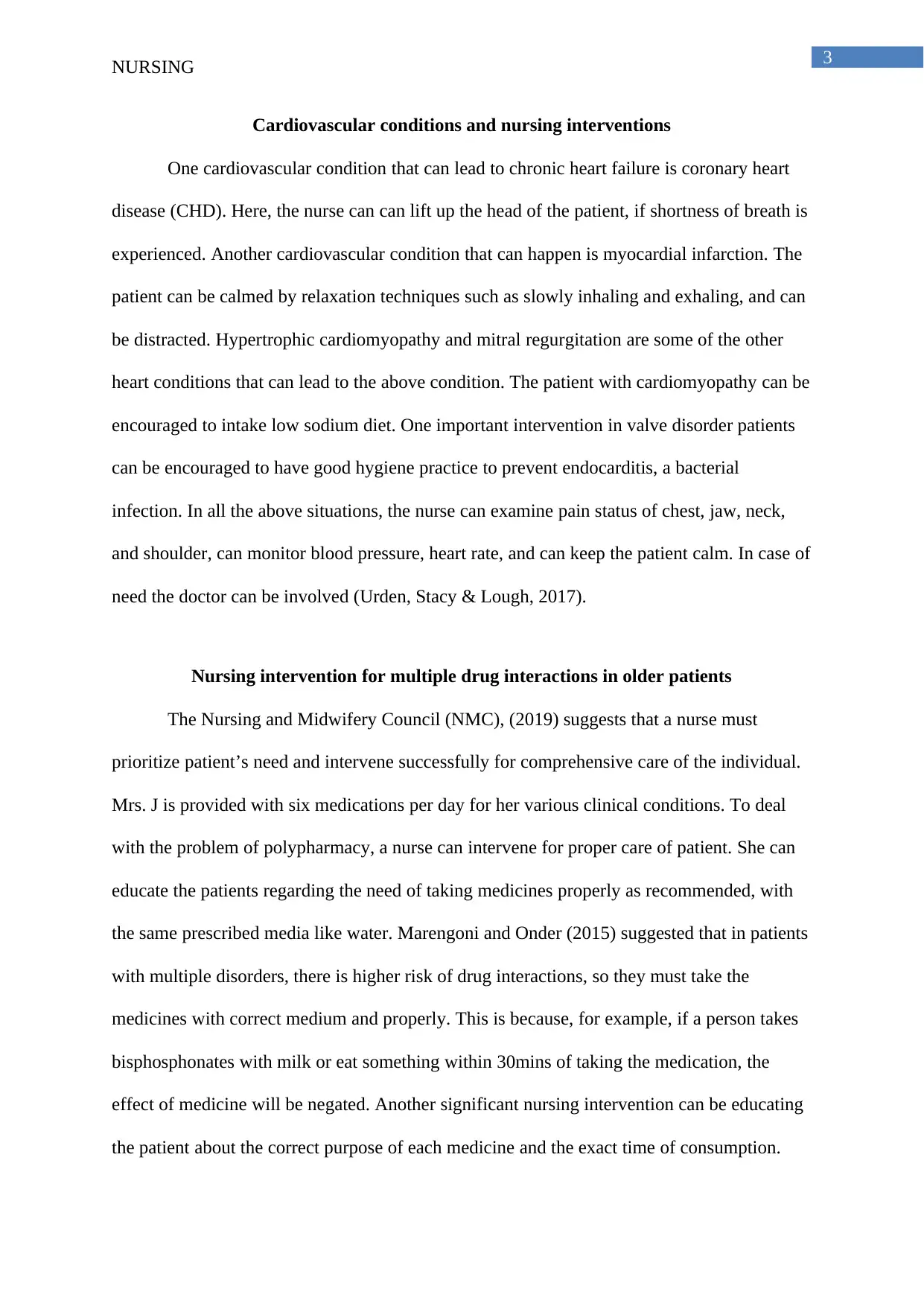
3
NURSING
Cardiovascular conditions and nursing interventions
One cardiovascular condition that can lead to chronic heart failure is coronary heart
disease (CHD). Here, the nurse can can lift up the head of the patient, if shortness of breath is
experienced. Another cardiovascular condition that can happen is myocardial infarction. The
patient can be calmed by relaxation techniques such as slowly inhaling and exhaling, and can
be distracted. Hypertrophic cardiomyopathy and mitral regurgitation are some of the other
heart conditions that can lead to the above condition. The patient with cardiomyopathy can be
encouraged to intake low sodium diet. One important intervention in valve disorder patients
can be encouraged to have good hygiene practice to prevent endocarditis, a bacterial
infection. In all the above situations, the nurse can examine pain status of chest, jaw, neck,
and shoulder, can monitor blood pressure, heart rate, and can keep the patient calm. In case of
need the doctor can be involved (Urden, Stacy & Lough, 2017).
Nursing intervention for multiple drug interactions in older patients
The Nursing and Midwifery Council (NMC), (2019) suggests that a nurse must
prioritize patient’s need and intervene successfully for comprehensive care of the individual.
Mrs. J is provided with six medications per day for her various clinical conditions. To deal
with the problem of polypharmacy, a nurse can intervene for proper care of patient. She can
educate the patients regarding the need of taking medicines properly as recommended, with
the same prescribed media like water. Marengoni and Onder (2015) suggested that in patients
with multiple disorders, there is higher risk of drug interactions, so they must take the
medicines with correct medium and properly. This is because, for example, if a person takes
bisphosphonates with milk or eat something within 30mins of taking the medication, the
effect of medicine will be negated. Another significant nursing intervention can be educating
the patient about the correct purpose of each medicine and the exact time of consumption.
NURSING
Cardiovascular conditions and nursing interventions
One cardiovascular condition that can lead to chronic heart failure is coronary heart
disease (CHD). Here, the nurse can can lift up the head of the patient, if shortness of breath is
experienced. Another cardiovascular condition that can happen is myocardial infarction. The
patient can be calmed by relaxation techniques such as slowly inhaling and exhaling, and can
be distracted. Hypertrophic cardiomyopathy and mitral regurgitation are some of the other
heart conditions that can lead to the above condition. The patient with cardiomyopathy can be
encouraged to intake low sodium diet. One important intervention in valve disorder patients
can be encouraged to have good hygiene practice to prevent endocarditis, a bacterial
infection. In all the above situations, the nurse can examine pain status of chest, jaw, neck,
and shoulder, can monitor blood pressure, heart rate, and can keep the patient calm. In case of
need the doctor can be involved (Urden, Stacy & Lough, 2017).
Nursing intervention for multiple drug interactions in older patients
The Nursing and Midwifery Council (NMC), (2019) suggests that a nurse must
prioritize patient’s need and intervene successfully for comprehensive care of the individual.
Mrs. J is provided with six medications per day for her various clinical conditions. To deal
with the problem of polypharmacy, a nurse can intervene for proper care of patient. She can
educate the patients regarding the need of taking medicines properly as recommended, with
the same prescribed media like water. Marengoni and Onder (2015) suggested that in patients
with multiple disorders, there is higher risk of drug interactions, so they must take the
medicines with correct medium and properly. This is because, for example, if a person takes
bisphosphonates with milk or eat something within 30mins of taking the medication, the
effect of medicine will be negated. Another significant nursing intervention can be educating
the patient about the correct purpose of each medicine and the exact time of consumption.
Paraphrase This Document
Need a fresh take? Get an instant paraphrase of this document with our AI Paraphraser
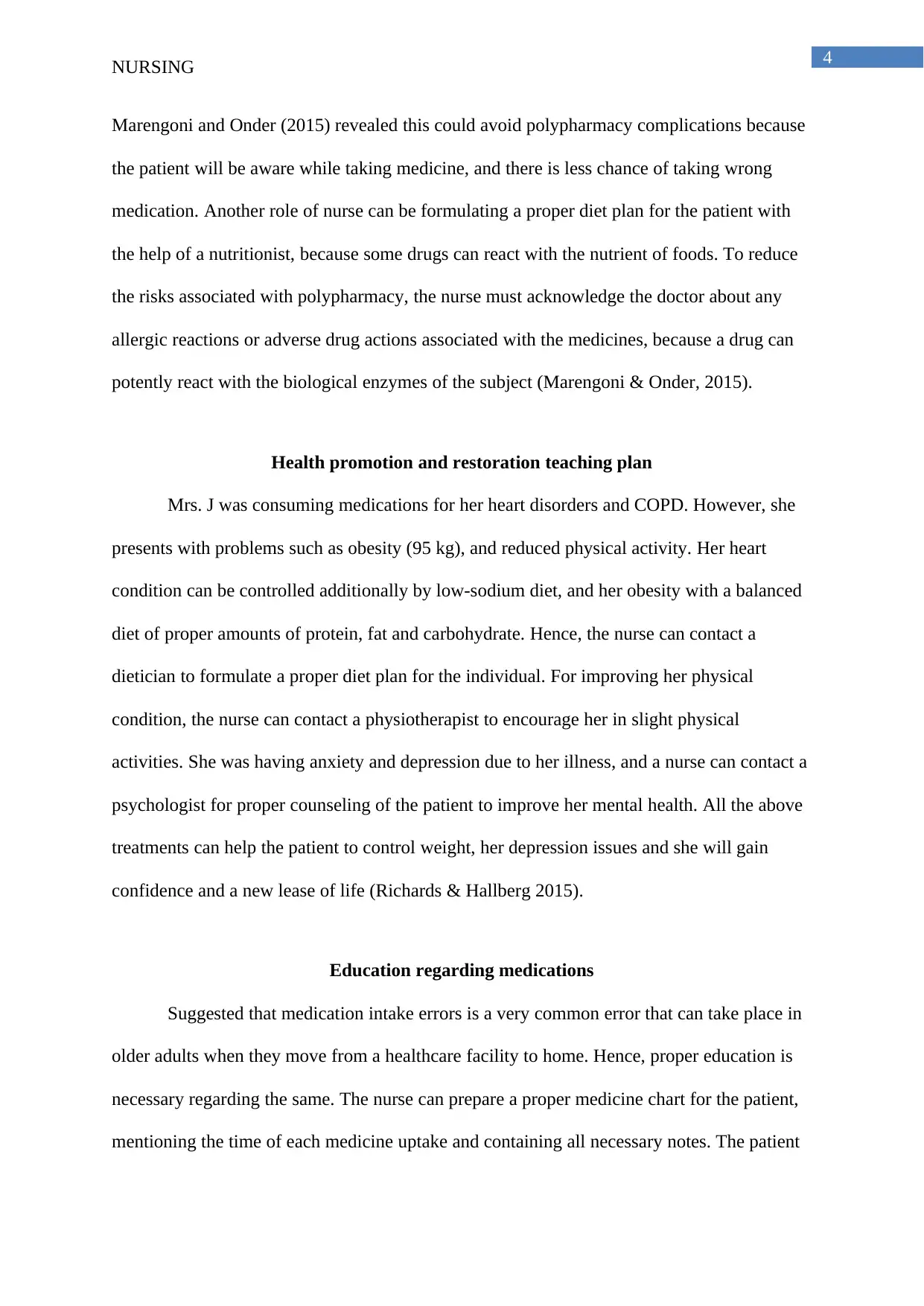
4
NURSING
Marengoni and Onder (2015) revealed this could avoid polypharmacy complications because
the patient will be aware while taking medicine, and there is less chance of taking wrong
medication. Another role of nurse can be formulating a proper diet plan for the patient with
the help of a nutritionist, because some drugs can react with the nutrient of foods. To reduce
the risks associated with polypharmacy, the nurse must acknowledge the doctor about any
allergic reactions or adverse drug actions associated with the medicines, because a drug can
potently react with the biological enzymes of the subject (Marengoni & Onder, 2015).
Health promotion and restoration teaching plan
Mrs. J was consuming medications for her heart disorders and COPD. However, she
presents with problems such as obesity (95 kg), and reduced physical activity. Her heart
condition can be controlled additionally by low-sodium diet, and her obesity with a balanced
diet of proper amounts of protein, fat and carbohydrate. Hence, the nurse can contact a
dietician to formulate a proper diet plan for the individual. For improving her physical
condition, the nurse can contact a physiotherapist to encourage her in slight physical
activities. She was having anxiety and depression due to her illness, and a nurse can contact a
psychologist for proper counseling of the patient to improve her mental health. All the above
treatments can help the patient to control weight, her depression issues and she will gain
confidence and a new lease of life (Richards & Hallberg 2015).
Education regarding medications
Suggested that medication intake errors is a very common error that can take place in
older adults when they move from a healthcare facility to home. Hence, proper education is
necessary regarding the same. The nurse can prepare a proper medicine chart for the patient,
mentioning the time of each medicine uptake and containing all necessary notes. The patient
NURSING
Marengoni and Onder (2015) revealed this could avoid polypharmacy complications because
the patient will be aware while taking medicine, and there is less chance of taking wrong
medication. Another role of nurse can be formulating a proper diet plan for the patient with
the help of a nutritionist, because some drugs can react with the nutrient of foods. To reduce
the risks associated with polypharmacy, the nurse must acknowledge the doctor about any
allergic reactions or adverse drug actions associated with the medicines, because a drug can
potently react with the biological enzymes of the subject (Marengoni & Onder, 2015).
Health promotion and restoration teaching plan
Mrs. J was consuming medications for her heart disorders and COPD. However, she
presents with problems such as obesity (95 kg), and reduced physical activity. Her heart
condition can be controlled additionally by low-sodium diet, and her obesity with a balanced
diet of proper amounts of protein, fat and carbohydrate. Hence, the nurse can contact a
dietician to formulate a proper diet plan for the individual. For improving her physical
condition, the nurse can contact a physiotherapist to encourage her in slight physical
activities. She was having anxiety and depression due to her illness, and a nurse can contact a
psychologist for proper counseling of the patient to improve her mental health. All the above
treatments can help the patient to control weight, her depression issues and she will gain
confidence and a new lease of life (Richards & Hallberg 2015).
Education regarding medications
Suggested that medication intake errors is a very common error that can take place in
older adults when they move from a healthcare facility to home. Hence, proper education is
necessary regarding the same. The nurse can prepare a proper medicine chart for the patient,
mentioning the time of each medicine uptake and containing all necessary notes. The patient
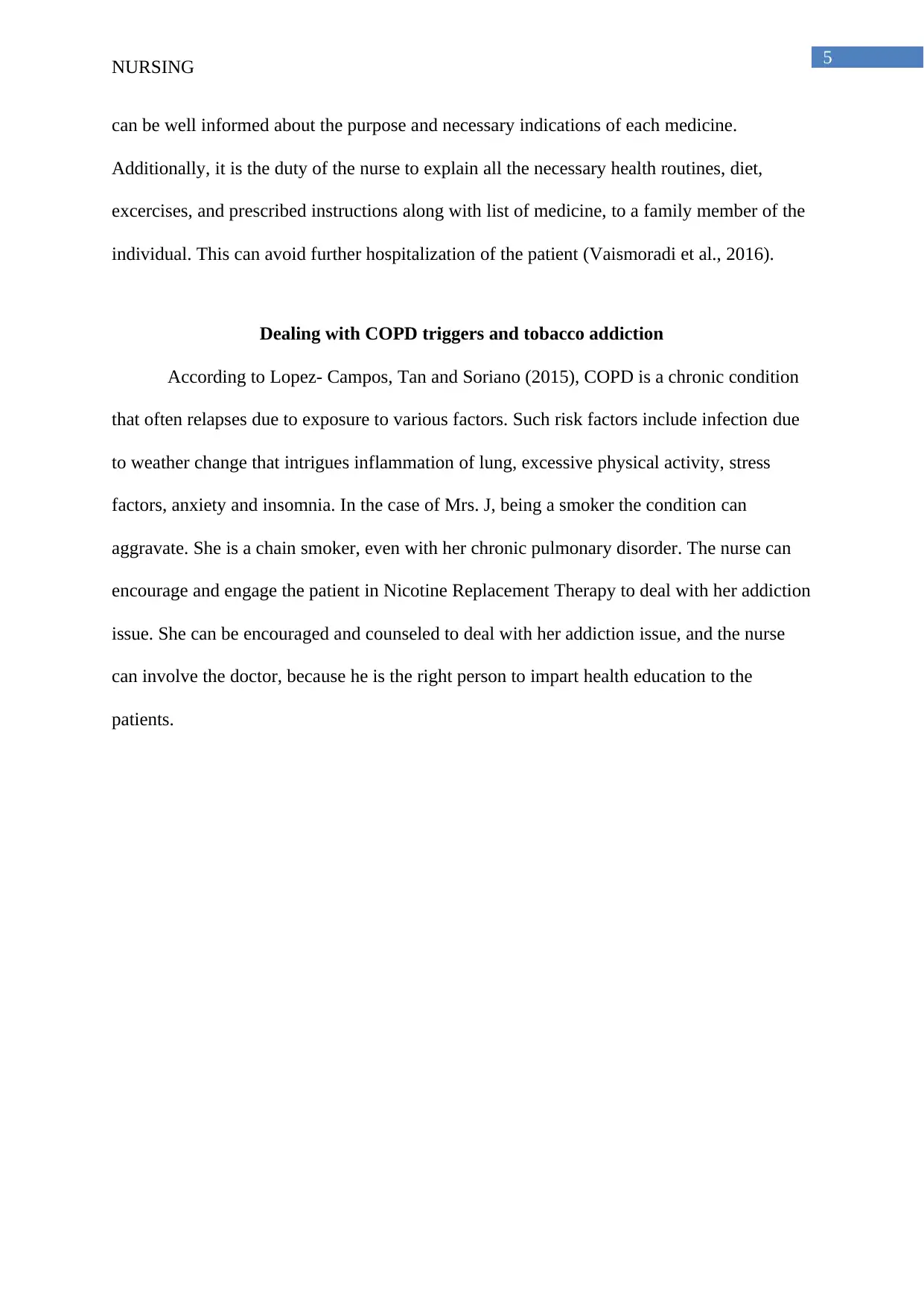
5
NURSING
can be well informed about the purpose and necessary indications of each medicine.
Additionally, it is the duty of the nurse to explain all the necessary health routines, diet,
excercises, and prescribed instructions along with list of medicine, to a family member of the
individual. This can avoid further hospitalization of the patient (Vaismoradi et al., 2016).
Dealing with COPD triggers and tobacco addiction
According to Lopez- Campos, Tan and Soriano (2015), COPD is a chronic condition
that often relapses due to exposure to various factors. Such risk factors include infection due
to weather change that intrigues inflammation of lung, excessive physical activity, stress
factors, anxiety and insomnia. In the case of Mrs. J, being a smoker the condition can
aggravate. She is a chain smoker, even with her chronic pulmonary disorder. The nurse can
encourage and engage the patient in Nicotine Replacement Therapy to deal with her addiction
issue. She can be encouraged and counseled to deal with her addiction issue, and the nurse
can involve the doctor, because he is the right person to impart health education to the
patients.
NURSING
can be well informed about the purpose and necessary indications of each medicine.
Additionally, it is the duty of the nurse to explain all the necessary health routines, diet,
excercises, and prescribed instructions along with list of medicine, to a family member of the
individual. This can avoid further hospitalization of the patient (Vaismoradi et al., 2016).
Dealing with COPD triggers and tobacco addiction
According to Lopez- Campos, Tan and Soriano (2015), COPD is a chronic condition
that often relapses due to exposure to various factors. Such risk factors include infection due
to weather change that intrigues inflammation of lung, excessive physical activity, stress
factors, anxiety and insomnia. In the case of Mrs. J, being a smoker the condition can
aggravate. She is a chain smoker, even with her chronic pulmonary disorder. The nurse can
encourage and engage the patient in Nicotine Replacement Therapy to deal with her addiction
issue. She can be encouraged and counseled to deal with her addiction issue, and the nurse
can involve the doctor, because he is the right person to impart health education to the
patients.
⊘ This is a preview!⊘
Do you want full access?
Subscribe today to unlock all pages.

Trusted by 1+ million students worldwide
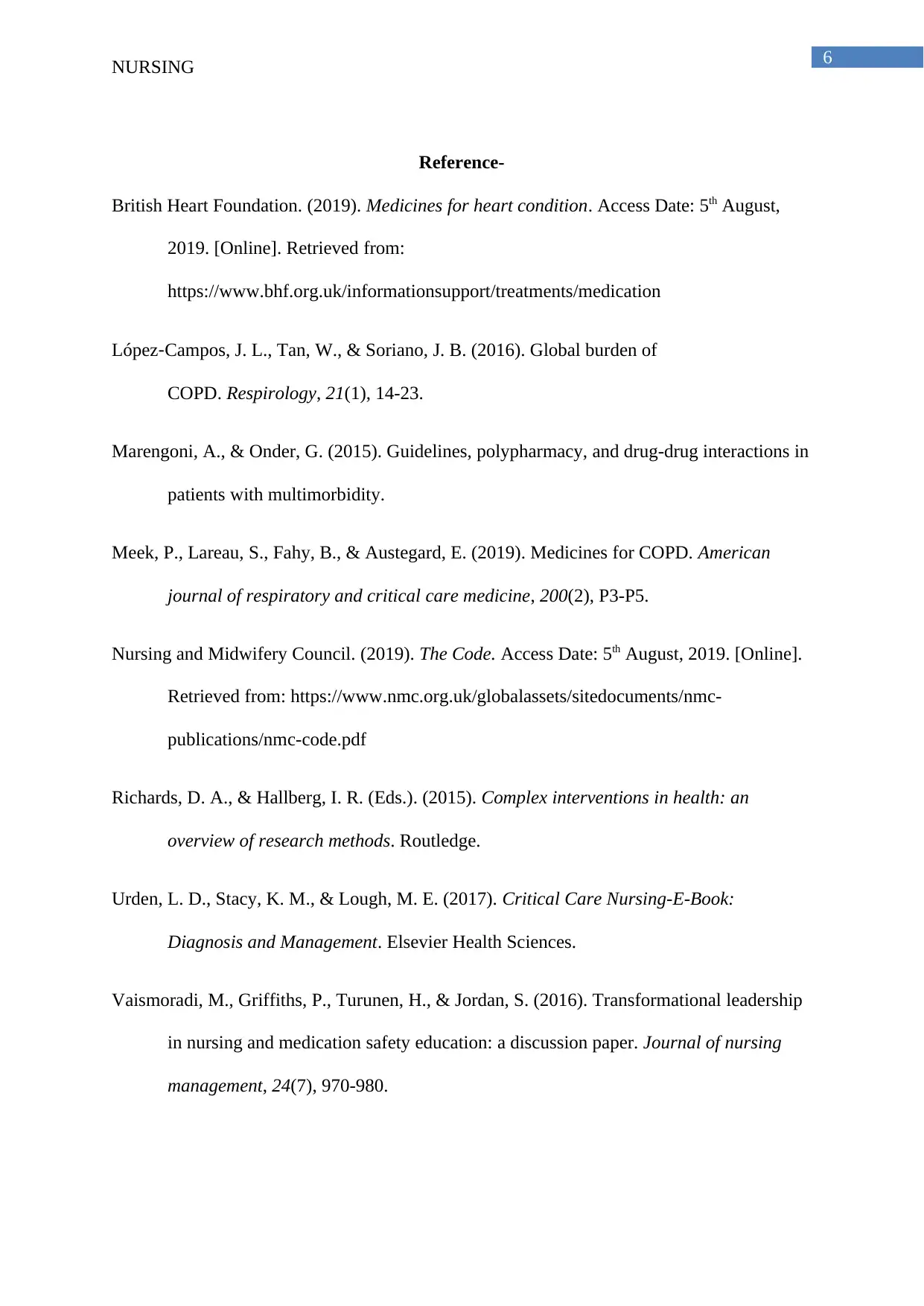
6
NURSING
Reference-
British Heart Foundation. (2019). Medicines for heart condition. Access Date: 5th August,
2019. [Online]. Retrieved from:
https://www.bhf.org.uk/informationsupport/treatments/medication
López‐Campos, J. L., Tan, W., & Soriano, J. B. (2016). Global burden of
COPD. Respirology, 21(1), 14-23.
Marengoni, A., & Onder, G. (2015). Guidelines, polypharmacy, and drug-drug interactions in
patients with multimorbidity.
Meek, P., Lareau, S., Fahy, B., & Austegard, E. (2019). Medicines for COPD. American
journal of respiratory and critical care medicine, 200(2), P3-P5.
Nursing and Midwifery Council. (2019). The Code. Access Date: 5th August, 2019. [Online].
Retrieved from: https://www.nmc.org.uk/globalassets/sitedocuments/nmc-
publications/nmc-code.pdf
Richards, D. A., & Hallberg, I. R. (Eds.). (2015). Complex interventions in health: an
overview of research methods. Routledge.
Urden, L. D., Stacy, K. M., & Lough, M. E. (2017). Critical Care Nursing-E-Book:
Diagnosis and Management. Elsevier Health Sciences.
Vaismoradi, M., Griffiths, P., Turunen, H., & Jordan, S. (2016). Transformational leadership
in nursing and medication safety education: a discussion paper. Journal of nursing
management, 24(7), 970-980.
NURSING
Reference-
British Heart Foundation. (2019). Medicines for heart condition. Access Date: 5th August,
2019. [Online]. Retrieved from:
https://www.bhf.org.uk/informationsupport/treatments/medication
López‐Campos, J. L., Tan, W., & Soriano, J. B. (2016). Global burden of
COPD. Respirology, 21(1), 14-23.
Marengoni, A., & Onder, G. (2015). Guidelines, polypharmacy, and drug-drug interactions in
patients with multimorbidity.
Meek, P., Lareau, S., Fahy, B., & Austegard, E. (2019). Medicines for COPD. American
journal of respiratory and critical care medicine, 200(2), P3-P5.
Nursing and Midwifery Council. (2019). The Code. Access Date: 5th August, 2019. [Online].
Retrieved from: https://www.nmc.org.uk/globalassets/sitedocuments/nmc-
publications/nmc-code.pdf
Richards, D. A., & Hallberg, I. R. (Eds.). (2015). Complex interventions in health: an
overview of research methods. Routledge.
Urden, L. D., Stacy, K. M., & Lough, M. E. (2017). Critical Care Nursing-E-Book:
Diagnosis and Management. Elsevier Health Sciences.
Vaismoradi, M., Griffiths, P., Turunen, H., & Jordan, S. (2016). Transformational leadership
in nursing and medication safety education: a discussion paper. Journal of nursing
management, 24(7), 970-980.
1 out of 7
Related Documents
Your All-in-One AI-Powered Toolkit for Academic Success.
+13062052269
info@desklib.com
Available 24*7 on WhatsApp / Email
![[object Object]](/_next/static/media/star-bottom.7253800d.svg)
Unlock your academic potential
Copyright © 2020–2025 A2Z Services. All Rights Reserved. Developed and managed by ZUCOL.





